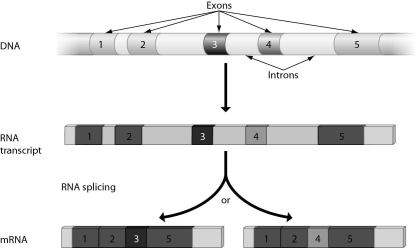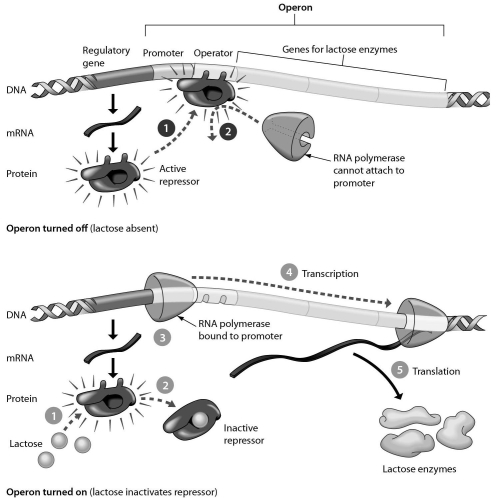A) operator
B) promoter
C) activator
D) repressor
Correct Answer

verified
Correct Answer
verified
Multiple Choice
Homeotic genes ______.
A) have very different sequences in plant cells as compared to animal cells
B) are an example of convergent evolution
C) are evidence of the common ancestry of eukaryotic organisms
D) regulate gene expression in both prokaryotic and eukaryotic cells
Correct Answer

verified
Correct Answer
verified
Multiple Choice
Please read the paragraph below to answer the following question(s) . Jim has become particularly interested in the genetic basis of cancer and has spent considerable time reading published papers about oncogenes. He learned that as early as 1972 researchers suggested that mutations in proto-oncogenes caused by carcinogens can convert them to oncogenes. He asked you to answer a couple of questions about this because he did not have the biology background to totally understand. -Jim learned that viruses can sometimes cause cancer and wants to know why.You tell him that ______.
A) a human cell can acquire a tumor-suppressor gene from a virus
B) a human cell can acquire a proto-oncogene from a virus
C) a human cell can acquire an oncogene from a virus.
D) some viruses are passed from mother to child and cause "inherited" cancers
Correct Answer

verified
Correct Answer
verified
Multiple Choice
Male tortoiseshell cats ______.
A) do not have an X chromosome
B) have orange and black patches of fur that reflect the pattern of X chromosome inactivation
C) are usually XYY individuals
D) are likely to be exceedingly rare and very likely to be sterile since normal male cats are XY
Correct Answer

verified
Correct Answer
verified
Multiple Choice
Introns are ______.
A) noncoding DNA sequences
B) DNA sequences to which activators bind
C) expressed DNA sequences
D) the product of RNA splicing
Correct Answer

verified
Correct Answer
verified
Multiple Choice
At one point,you were just an undifferentiated,single cell.You are now made of many cells; some of these cells function as liver cells,some as muscle cells,some as red blood cells,while others play different roles.What name is given to the process that is responsible for this?
A) gene expression
B) regeneration
C) carcinogenesis
D) cellular differentiation
Correct Answer

verified
Correct Answer
verified
Multiple Choice
The figure below illustrates ______. 
A) transcription factors
B) activators
C) alternative RNA splicing
D) protein activation
Correct Answer

verified
Correct Answer
verified
Multiple Choice
Reproductive cloning involves
A) reacquire the genes it lost during the course of development
B) come from an early stage of embryonic development
C) be dedifferentiated
D) be implanted in the egg of an organism that is capable of regenerating lost body parts
Correct Answer

verified
Correct Answer
verified
Multiple Choice
Possible uses of reproductive cloning include ______.
A) the production of genetically identical animals for experimentation
B) the production of organs in pigs for transplant into humans
C) restocking populations of endangered animals
D) all of the above.
Correct Answer

verified
Correct Answer
verified
Multiple Choice
What name is given to a gene that causes cancer?
A) pathogene
B) cancogene
C) homeotic gene
D) oncogene
Correct Answer

verified
Correct Answer
verified
Multiple Choice
______ is(are) responsible for more cancers than any other carcinogen.
A) Asbestos
B) UV radiation
C) Tobacco
D) X-rays
Correct Answer

verified
Correct Answer
verified
Multiple Choice
While examining a human cell that functions normally,you determine that it has 45 functional chromosomes and one chromosome that is almost completely inactive. You immediately decide that it is very likely that this cell ______.
A) came from a normal human female
B) is lacking a chromosome
C) is a gamete
D) will become cancerous if one or two more genes are mutated
Correct Answer

verified
Correct Answer
verified
Multiple Choice
Bacterial RNA polymerase binds to the ______.
A) operator
B) proto-oncogene
C) regulatory gene
D) promoter
Correct Answer

verified
Correct Answer
verified
Multiple Choice
The process by which genotype becomes expressed as phenotype is ______.
A) phenogenesis
B) transcription
C) gene expression
D) recombination
Correct Answer

verified
Correct Answer
verified
Multiple Choice
Repressors act by blocking the binding of _____ to the operator.
A) promoters
B) DNA polymerase
C) the operon
D) RNA polymerase
Correct Answer

verified
Correct Answer
verified
Multiple Choice
What is the first level of control of eukaryotic gene transcription?
A) RNA splicing
B) attachment of RNA polymerase to the promoter
C) DNA packing and unpacking
D) the binding and unbinding of transcription factors to enhancer sequences
Correct Answer

verified
Correct Answer
verified
Multiple Choice
More people die of ______ cancer than of any other cancer.
A) lung
B) skin
C) pancreatic
D) breast
Correct Answer

verified
Correct Answer
verified
Multiple Choice
In bacteria,what name is given to a cluster of genes with related functions,along with their DNA control sequences?
A) operon
B) activator
C) promoter
D) exon
Correct Answer

verified
Correct Answer
verified
Multiple Choice
The lac operon is shown in the accompanying figure.Answer the following question after reviewing the figure.The lac operon is usually in the ______ position and is activated by ______. 
A) on... the repressor
B) off... lactose
C) of... the repressor
D) on... the promoter
Correct Answer

verified
Correct Answer
verified
Multiple Choice
Which risk factors are associated with cancer of the colon and rectum?
A) tobacco
B) viruses
C) UV radiation
D) dietary fat
Correct Answer

verified
Correct Answer
verified
Showing 21 - 40 of 41
Related Exams